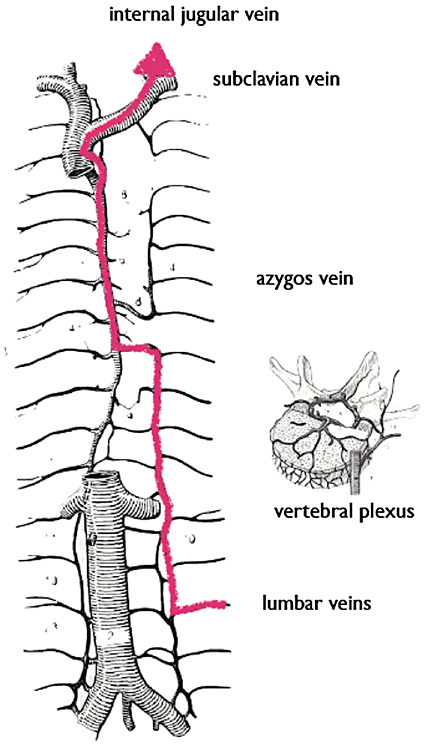CLINICAL HISTORY
An 11‐year‐old girl was operated on for severe left thoracolumbar scoliosis (Cobb angle 65°). Pedicular screws insertion and rod positioning was technically successful, but five days later, for signs of an early infection, a surgical wound revision was performed by debridement of necrotic tissues and hydrogen peroxide pressure irrigation of the operative field. Unexpectedly, during the procedure, the patient had two episodes of bradycardia followed by ventricular fibrillation, electromechanical dissociation, and pulmonary edema, and she died despite immediate resuscitation efforts.
GROSS PATHOLOGY
Autopsy demonstrated the correct positioning of pedicular screws and rods (Figure 1), with external signs of dehiscent wound in the lumbar region. There were no signs of pulmonary embolism nor were there any associated cardiac defects, such as a patency of foramen ovale. Gross examination of the brain showed diffuse abnormalities within the cerebral veins (Figure 2, arrows).
Figure 1.

Figure 2.

MICROSCOPIC PATHOLOGY
Neuropathological examination is represented in figure 3.
Figure 3.

What is the diagnosis?
DIAGNOSIS
A diffuse paradoxical cerebral air embolism of cortical veins.
DISCUSSION
Prolonged prone position, large tissues opening and hydrogen peroxide pressure irrigation represent well known risk factors for pulmonary air embolism in spine surgery 1, 2, 4. Paradoxical cerebral air embolism, without pulmonary involvement, is a rare complication during spine surgery and to date it has been always associated to patency of foramen ovale 3, 5. Nevertheless, in our case, post‐mortem examination excluded with certainty any cardiac or vascular defects. Then we can speculate that air bubbles would have reached cerebral veins starting from the venules of muscles and overlying teguments along the infected wound; they would have reached the posterior extra‐spinal venous plexus and from there, through the lumbar ascending veins and the azygos‐hemiazygos vein system, they would have entered the superior vena cava, bypassing the pulmonary circulation. Finally in a retrograde manner, through the jugular veins, air bubbles would have filled dural venous sinuses and cortical cerebral vein system, causing the patient's death (Figure 4).
Figure 4.

This is the first case describing a fatal paradoxical air venous cerebral embolism in a pediatric patient undergone spine surgery without cardiac defects.
ABSTRACT
We report the case of an 11‐year‐old girl operated on for a severe left thoracolumbar scoliosis. Pedicular screw insertion and rod positioning was technically successful, but five days later, for signs of an early infection, the wound revised and unexpectedly the patient died during surgery. Autopsy recognized a diffuse cerebral cortical venous air embolism as the cause of death and excluded pulmonary embolism and associated cardiac defects. This is the first and unique case describing a fatal paradoxical air venous cerebral embolism in a pediatric patient undergone spine surgery: the possible mechanism involving azygos and jugular veins systems is discussed.
REFERENCES
- 1. Brown J, Rogers J, Soar J (2001) Cardiac arrest during surgery and ventilation in the prone position: a case report and systematic review. Resuscitation 50:233–238. [DOI] [PubMed] [Google Scholar]
- 2. Despond O, Fiset P (1997) Oxygen venous embolism after the use of hydrogen peroxide during lumbar discectomy. Can J Anaesth 44:410–413. [DOI] [PubMed] [Google Scholar]
- 3. Eck JC, Humphreys SC, Patil VD, Hodges SD, Clarke SE, Davare JR (2006) Paradoxical embolus causing transient bilateral blindness following spinal surgery. Am J Orthop 35:527–529. [PubMed] [Google Scholar]
- 4. Morikawa H, Mima H, Fujita, Mishima S (1995) Oxygen embolism due to hydrogen peroxide irrigation during cervical spinal surgery. Can J Anaesth 42:231–233. [DOI] [PubMed] [Google Scholar]
- 5. Pham Dang C, Péréon Y, Champin P, Delécrin J, Passuti N (2002) Paradoxical air embolism from patent foramen ovale in scoliosis surgery. Spine 27:E291–E295. [DOI] [PubMed] [Google Scholar]


